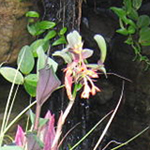
 |
 |
|
Most Common Orchids
Other Links
|
| Home | | | Anguloa | | | Cattleya | | | Cymbidium | | | Oncidium | | | Epidendrum | | | Catasetum | | | Miltonia | | |
|
Epidendrum
Epidendrum is easily propagated. It can yield many plants from one stem. This orchid needs bright light and can be grown in fine textured orchid mix. Compost consisting bark, tree fern fibre and sphagnum moss is suitable for Epidendrum. During growing season it require plenty water & fresh air fertilizers must be used every two weeks with a diluted orchid food. Regular use of fertilizer responds with denser flower spikes, greener, stronger leaves and more robust roots.
It is a free flowering orchid and the colors range from yellow to white, pink, orange & purple. It has upright, clumping growth habit with roots emerging from base of the stem, below soil level. Mostly the plant is free of insects and flower reliably throughout the year.
If the spike is left on the plant after flowering then it will flower again in few months. Spike is prone to produce a keikis (baby plant) after flowering. Plants grown in low light may need to be staked; while those growing are full sun is usually self-supporting.
A few prominent varieties of Epidendrum orchid are :
Epidendrum aromaticum.
Epidendrum cochleatum.
Epidendrum moyobambae.
Epidendrum radiatum.
Epidendrum aromaticum.
Epidendrum cochleatum.
Epidendrum moyobambae.
Epidendrum radiatum.
Water : Plants need abundant moisture at their roots during active growth. It must be place in very well draining medium. During cool weather, water once or twice times a week whereas in hot weather at least 3 times a week.
Light : This plant requires large amount of light. The best location for the plant is an east facing area, where plant gets morning sun not hot afternoon sun.
Temperature : The temperature range for the plant ranges from 50˚F to 85 ˚F. Although certain species from higher altitude needs cooler temperature.
Potting : Repotting can be done when all flowering are ceased. Warm water soak for 10 min make roots pliable and makes easier to remove from container that helps to minimize root damage. The best container for the plant is clay orchid pots. Water evaporates faster in clay pots than in plastic pots. Similarly wooden baskets allow free airflow over the roots and eliminate over water problems. Newly repotted plants should be placed in slightly lower lights for several weeks.
Fertilizer : During spring to early fall, fertilizer must be used every seven days, with several clear watering. Similarly in late fall to winter, light feeding once a month is sufficient. While fertilizing use 20-20-20 with tree fern, charcoal or various inorganic appregates but use 30-10-10 with fir bark. Fertilizer formula must match potting medium. We can use Grow more fertilizers. Which have micronutrients, which provide strength for the new growth & support for the flowers.
Interesting facts : Once the plant stopped flowering, leave the spike & it will flower again. As we know spike give birth to keiki, & this keiki give rise to new roots and new plant. Once the root grows bit longer, new plant can be safely transported to its new pot or habitat.
Uses:
· An affordable deal to decorate the garden in a superb manner. Epidendrum orchid makes well-adored garden.
· Easily adaptable, the plant does not even need extra care or pesticides & fungicides, as it is resistant to pests & diseases.
· Florists love the little flowers along with their inflorescence as it makes super flower.
· The green foliage that lures towards making it a great garden plant.
· An affordable deal to decorate the garden in a superb manner. Epidendrum orchid makes well-adored garden.
· Easily adaptable, the plant does not even need extra care or pesticides & fungicides, as it is resistant to pests & diseases.
· Florists love the little flowers along with their inflorescence as it makes super flower.
· The green foliage that lures towards making it a great garden plant.
